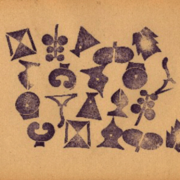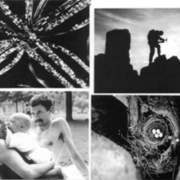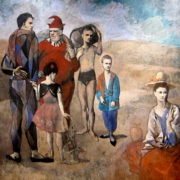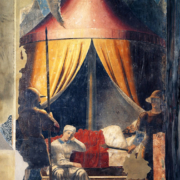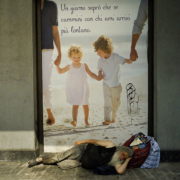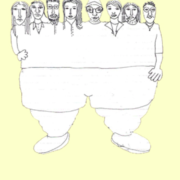Introduction, Narcissism and group
Sigmund Freud, in “Totem and Taboo” (1912-13) and in “ Psychology of the masses and Ego analysis” (1921) provided us with ideas in order to approach the complex theme of relationships between narcissism and group. It is known as Freud made use of Darwin’s hypothesis about the origins of human society, so he described a primeval horde, dominated by a strong male, put together by libidinal relationships (1912). Focusing on the identification processes which happen between horde members and the idealized leader, Freud affirmed that the process of identification since the beginning had been intrinsically ambivalent and could not even cause any metaphoric version and a cannibal incorporation and distribution of the loved object. Such a dominating person could be “absolutely narcissistic” and “self sufficient”. This figure might have the nature of the leader who, doesn’t love the members of the mass, while these last ones have often the illusion about being loved from their primeval father and sob they are submitted to his authority. Freud (1921) affirmed – quoting ironically Nietzsche-that Nietzsche’s superman – standing over the flock of mediocre people- would belong to the past of human history rather than to the future, as the philosopher claimed. Today we could think in the light of present geopolitical events that they were both right. Besides, the libidinal, idealised conception of the leader a persecuting aspect exists, according to Freud, because of this, children in the primeval group, would feel even controlled and threatened by their father and they would be frightened of him. We can’t forget that Freud had just elaborated his theory of the double drive matrix in “Beyond the principle of pleasure”(1920) and that the two sages share many connections. In addition, Freud mentioned two highly organised and lasting masses: the church and the army. These masses would be protected from disintegration and from natural transience just from their hierarchic structure centred on the figure of the leader: if this figure fails and consequently that mixture of expectations, love and punishment which are addressed to him fails, the group quickly breaks up. Also Elias Canetti in his “Crowds and Power”(1960) considered these “Mass-Crystals” constituted by the clergy and militia, they are disciplined and submitted to a strong authority, to “leadership” and hence they are protected against dissolution through hierarchy. The concept of narcissism includes so a wide range of meanings to prevent us from giving reductive and univocal definitions. If we underline the motivational value of the improvement of the self, of self promotion, of assertiveness we could follow Freud in connecting the individuals belonging to the horde (“The Pack”by Canetti) with the figure of the leader on the basis of narcissism. Narcissistic drives would be just the basis of both positive and destroying aspects, they would support the mutual relationship between guide and followers. The religious, military political leader would embody the narcissistic ideal of the crowd, behaving as a representative and a manager of their ambitions that the simple components cannot properly realise. This delegation of power would be an aggregation factor for human groups, who would share the investiture of their leader. Bion’s conception of basic assumptions keeps in its originality echoes of these assertions by Freud. In a special way, the assumption of dependence- which more clearly connects itself with the relationship with a divinized and protecting figure- defines an all-powerful fancy which deeply unites the group in the collective belief in belonging to an immature organism, but primitively confident about a superior identity which will meet all its needs. I think that even the other basic assumptions are connected with the relationship with the figure of an absolute leader. In fact both the waiting for the messiah in the assumption of pairing, and the tendency to identify an exterior enemy, in the fight-flight assumption, present evident traces of the Freudian conception. One can hypothesise that in the figure of the outside enemy, the destroying divided split valences belonging to the same highly idealised leader are projected. The primitive operations, already described, seem to be connected with the need of reaching a basic form of cohesion and the definition of identity, so widely using the processes of splitting and projection of the undesirable parts in “different” and “enemy groups”. As matter of fact, they are really similar and symmetric for primordial defences. You can think how important it is in adolescence belonging to a peer group. This group should be both homosexual and heterosexual and how relevant it is the submission to hierarchy of values and dominating figures in the group itself and the tendency to expel to other groups the unpleasant components. If then the group of young undesirable people becomes a gang in which their common aims have antisocial tendencies, these conceptual patterns appear even more involving. The football fan is another current, relevant phenomenon, which can be understood by the same means, resulting in violence intemperance which go hand to hand with this phenomenon. As for the strong tendency of a part of young masses to idolise pop music stars, Freud (1921, ibid) had already underlined the similarity in the theme of the narcissism of group. How can we define, then, the social and political phenomena which trouble us nowadays? It appears that the serious problems regarding the control of energetic sources and of environmental management are still widely set and explained according to the archaic mechanisms of how masses and groups function, masterly described by Freud, Canetti, Bion, in spite of international diplomatic efforts to create special “work-group”. Such archaic mechanisms lead to a very high level conflict, understandable in psychoanalytic terms as a derivation from rudimentary procedures of mental organization. In the issue of Funzione Gamma Journal, devoted to the theme “Narcissism and Group” some interesting works appeared facing and analysing this topic, capable of constituting such coicidentia oppositorum to be a real challenge for those who try to define it. In “Primary Narcissism and the Group” Marta Segoviano started just from “Psychology of Masses” referring to the Freudian concept of primary identification in which a convergence is realised between ego and object, under the protection of idealisation and then she made use of the contributions due to di Anzieu, Aulagnier, Bernard, Missenard, Kaës, Bion. Like Freud, Bernard Duez in his rich and complex “ Primary Narcissism or Originary Narcissism” distinguished two forms of primary narcissism: in the first the ego places itself as an object of itself, in the second, instead the ego places itself in a condition deprived from any object, whose foetal life would be the prototype. He claimed that the groups of neurotic patients would express the first modality of narcissism, while the groups with borderline patients aimed at reaching an anobjectal narcissistic state. On this point Duez quoted Bleger and his concept of depositary of ambiguous components in the framework: the group situation would act as a framework for the deposit of the most archaic parts, cleaved but not divided inside human psyche. Marcos Bernard considered in his “The Unconscious and Narcissism in Subjects Who Have Ties” the different forms of agreement, entered among the members of a group. An evident, conscious agreement is followed by a secondary process which, according to this perspective, is supported by unconscious agreements and terms negotiating by the secondary process. Bernard claimed that both on conscious and unconscious level agreements are reached “by adding something” while on the unconscious level which is not removed yet the process occurs “by hewing”. In fact the dominating narcissism, never accepts anything admitting an otherness and makes use of negation(denial) in order to survive (to remain). In such a state one cannot speak about real and proper agreements but only about unconscious pacts. Romolo Petrini underlined in his paper about the process of individuation as the psychoanalytic group gets from the figure of the mythic founding master a feeling of strength, coherence and stability, protecting it from guilt and destruction. Such a symbiotic condition is useful to guarantee the identity of the group. It carries out a constructive function in the alternation with an opposite element, the individuation which is characterised by the tendency to detachment, to separation and autonomy. The dialectics, developing between the two factors in this perspective, involves the growth of the group itself. In “The Narcissistic Wound in Diabetes”, the authors Antonia Staforelli and Rosa Martinez, face the problem of psychic elaboration in group of their organic disease. The fabulous images appearing in the work were provided by the young patients: they swing between depressing anguishes and maniacal defences in the direction of a desirable passing of the “ narcissistic bulwark” allowing to live together with precariousness and the chance to help oneself..
It is evident from these short notes how complex the theme is and the variety of the approaches proposed by the different authors. these new studies enrich with new aspects the classical perspectives.
Comment about the image
The shapes I paint come from inside my mind and not from my visual perceptions of the outside world. They arise from boundless combinations due to few precursory elements: the square, the circle, the triangle, the cross. In drawing, free from didactic influences, children produce aggregates like these in the period following when they are two. Such self produced elements constitute the foundation, the germinative stratum for different evolving lines of drawing: pictograms, ideograms, letters, figures. In my own version signs are free from symbolic specific aims: they represent only what they are and don’t replace anything else. This linguistic exercise makes up formal, clean but unsaturated structures, stimulating associations. The observer is driven to read and complete all that is still in these shapes and so to contribute to the process of Gestaltung, of training interpreting at its turn images and their relationships. The image chosen to be moved towards the concept of narcissism and group is characterised by a multiplicity of formal confluent elements, such to suggest the concept of group yet they are clearly defined in their respective individualities and they remain restricted to their formal aspect, without fusing together. I think that from the contrast between these two aspects of multiplicity and differentiation, derived from profiles, is expressed the antinomy between narcissistic individuality and membership of the group.

